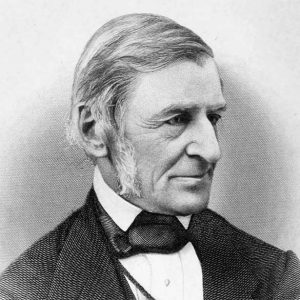Kristina West, University of Reading
Waldo was Emerson’s first-born child and just five years old when he died of scarlet fever on 28 January 1842. His father wrote in his journal: “Yesterday night at 15 minutes after eight my little Waldo ended his life” (47). Many other journal entries and letters attest to Emerson’s grief at the loss of his son, yet critics frequently look to his public works for evidence of his response; in particular, the essay “Experience” and the poem “Threnody”, which reference “my son” (167) and “boy who made dear his father’s home” (294) respectively. Although Emerson does not name the child in either of these works, the textual child has been designated by critics as the lived or biographical boy, Waldo.
Perhaps this naming of the textual child explains why these critics judge what they have figured as Emerson’s response as a father to the death of his son as lacking or inappropriate to the point of abhorrence, in a focused attack that centres primarily around the following lines:
In the death of my son, now more than two years ago, I seem to have lost a beautiful estate,– no more. I cannot get it nearer to me. If to-morrow I should be informed of the bankruptcy of my principal debtors, the loss of my property would be a great inconvenience to me, perhaps for many years; but it would leave me as it found me,– neither better nor worse. So it is with this calamity: it does not touch me (167).
The reactions to these lines have been of shock, outrage, and distaste. Max Cavitch writes of “the observation that appalls so many readers” and that “[m]any of [‘Experience’’s] readers […] conclude that Emerson is obscenely imagining himself to be in a position to sacrifice what he has in fact already lost” (155, 175). Sharon Cameron claims that “the […] comparison of Waldo’s death with the loss of an estate – is shocking” and describes “the vulgarity of alluding to these losses as if they were comparable” (208). And Mary Chapman refers to the “shockingly material figurations of loss” (76).
Yet is Emerson claiming a belief that a child is, or should be, comparable to property? Indeed, if there is a reduction of the dead and of the child to monetary value in “Experience”, is it a reduction that Emerson as author is not guilty of, as he is in the eyes of the critics, but instead actually stands alongside them as co-accuser? The text is split, expressing that sense of dislocation in which a child should not be comparable, yet still somehow is – “I seem to have lost […] I cannot get it nearer to me” – and that dislocation therefore does not hold, with the argument caught between the desire and what is constructed as the reality. Such critical responses also appear to reply on a reading of this claim only, without recourse to the rest of the essay and its consideration of the nature of illusion and the difficulties of human experience; in a similar message to ‘Threnody’, Emerson must let go of that which “we clutch hardest” (167) to effect a return.
Even without this conclusion, however, the critics’ responses rely on their own response to childhood that relies – just as their own reading of Emerson does – on certain assignations of value to children by adult readers and writers. Their assumption of the child’s sentimental value to the total exclusion of any economic value is a post-Romantic idealisation: in Pricing the Priceless Child, Viviana A. Zelizer discusses the changing social value of children from economic to sentimental, claiming: “By the mid-nineteenth century, the construction of the economically worthless child had been in large part accomplished among the American urban middle class” (5).
Yet the critical conclusion relies on certain assumptions about the child’s privileged status: in 1844, thousands of American children were still designated as property, largely due to slavery and indentured employment, or were required to work due to poverty, or chose to work outside the home. The shock that the critics claim to feel, therefore, appears based on a 20th– or-21st-century valuation of what a child should be, one that fails to read both Emerson’s position within such claims and their own limitations in terms of who might be assigned the status of the sentimentally valuable child. This is not to claim that these critics were ignoring the realities of childhood in nineteenth-century America, but rather that such easy sentimentalization and its accompanying outrage risks disenfranchising already marginalized children still further.
Works Cited
Cameron, Sharon. “Representing Grief: Emerson’s ‘Experience’”, The New American Studies: Essays from Representations, University of California Press, 1991, pp. 201-227.
Cavitch, Max. American Elegy: The Poetry of Mourning from the Puritans to Whitman, University of Minnesota Press, 2007.
Chapman, Mary. “The Economics of Loss: Emerson’s ‘Threnody’”, The American Transcendental Quarterly, June 2002.
Emerson, Ralph W. “Experience” (1844), Selected Writings of Ralph Waldo Emerson, ed. Robert D. Habich, Broadview Press, 2018, pp. 164-185.
–, Journal K, MS Am 1280H, Houghton Library, Harvard University.
–, “Threnody” (1844), The Collected Works of Ralph Waldo Emerson, Volume IX: Poems, A Variorum Edition, ed. Albert J. von Frank and Thomas Wortham, The Belknap Press of Harvard University Press, 2011, pp. 287-302.
Zelizer, Viviana A. Pricing the Priceless Child, Princeton University Press, 1985.
[Return to the Transparent Eyeball]
How to cite this post
Kristina West. “‘I seem to have lost a beautiful estate’: Childhood and property in Emerson’s ‘Experience’.” The Transparent Eyeball, Fourth Series, The Ralph Waldo Emerson Society, November 8, 2021, emersonsociety.org/the-transparent-eyeball/emerson-health/. Accessed [date of access; ex. 5 Dec. 2021].
West, K. (2021, November 8). ‘I seem to have lost a beautiful estate’: Childhood and property in Emerson’s ‘Experience’. The Transparent Eyeball. emersonsociety.org/the-transparent-eyeball/emerson-health/.
West, Kristina. “‘I seem to have lost a beautiful estate’: Childhood and property in Emerson’s ‘Experience’,” The Ralph Waldo Emerson Society. The Transparent Eyeball, November 8, 2021 emersonsociety.org/the-transparent-eyeball/emerson-health/.
